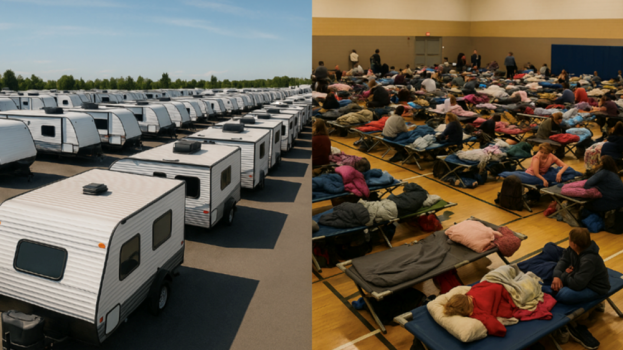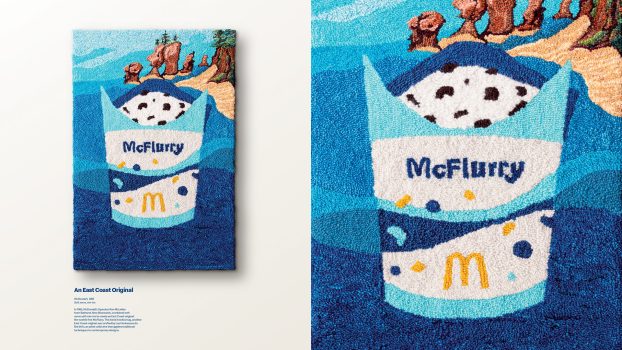
French multi-specialist sports brand Decathlon – founded in Lille in 1976, and now operating over 1,700 stores in 72 countries – is officially rebranding this year. And while the company has been internationally renowned for years, Philippe Gariépy, brand marketing manager at Decathlon Canada, acknowledges that it might seem a little strange for a brand that’s only been in Canada since 2018 to be going for a face lift already. “Decathlon has been present internationally for 48 years, and its identity dates back to the ’90s,” he explains. “It was simply time for a bit of change and modernity, but with respect to our heritage.”
The move, however, also reflects a recognition of changing demographics. “Since our customers are changing, we need to evolve with them and we also need to reflect our new ambition of becoming seen as more of a sports brand,” says Gariépy. The strategic step is meant to align customers’ perception of Decathlon with the one that the company has of itself, bridging the gap between being seen merely as a sporting goods retailer and being recognized as a sports brand with a commitment to innovation.
The rebranding initiative, of course, is supported by data and insights gleaned from extensive customer and market research that was spearheaded by Decathlon global in the last couple of years. In Canada, for example, Decathlon is overwhelmingly thought of as a distributor or a sporting goods store. But the company is more than that – it’s an holistic brand that invests in design and R&D. The brand aims to create a deeper emotional connection with customers, in order to go beyond this traditional rational appeal of quality products at competitive prices.
One of the prominent shifts is the decision to emphasize the concept of fun in sports and the communal aspect of exercise. With this angle, Decathlon’s tagline has changed from “Sports for all. All for sports.” to “Ready to Play?,” encapsulating the emotionally positive attributes that sports can bring into everyday life.
With this progression comes the unveiling of a revamped visual identity, one that has the goal of being more dynamic: a new logo and the incorporation of energetic colours. The logo, called “the Orbit,” represents movement, circularity, and proximity to nature with the shape of a mountain, resonating with the company’s commitment to both sports, the outdoors and sustainability.
Decathlon’s customer and market research also revealed additional intriguing findings, like the fact that, in Canada, despite regular participation in sports, many do not see themselves as athletic. “Sixty-four percent of Canadians don’t consider themselves that way. Even the people who are involved in sports almost every day, 49% of them don’t consider themselves athletic either,” shares Gariépy. A part of the retailer’s new strategy aims to change this. When the brand looked at other big sports brands, it noticed the focus was always on performance and improvement. “They’re always talking about pushing limits, messaging that can be very intimidating for some. With our new positioning, we want to put the spotlight back on what’s really important: fun and what sport can bring to people’s lives.”
And so, as Decathlon pivots towards a more resonant branding, it’s reinforcing its mission of making sports accessible for all. In that vein, the brand has streamlined its portfolio into nine categories including Quechua (mountain), Tribord (water and wind), Rockrider (outdoor cycling), Domyos (fitness), Kuikma (racket), Kipsta (team sports), Caperlan (wildlife), Btwin (urban gliding and mobility) and Inesis (target), along with four expert brands Van Rysel, Simond, Kiprun and Solognac.
Underpinning this global strategy, which seeks to redefine the customer experience, is a renewed sense of commitment to sustainability. Central to Decathlon’s ethos is the principle that the benefits of sport should not come at the planet’s expense. The company has pledged to achieve Net Zero emissions by 2050, setting intermediate goals for 2026 and 2030. This is matched by an approach to decarbonizing the brand’s supply chain, enhancing product lifecycles and encouraging a culture of reuse, repair and recycle among its customers.
In line with those efforts, Decathlon is recycling old fixtures and ensuring a phased approach that respects the environment. The company explores innovative concepts like second-hand markets and buyback programs, with a long-term vision to reduce the carbon footprint and support a circular economy.
Digital innovation plays a crucial role in all of this, with a complete overhaul of the company’s e-commerce platform to offer seamless online shopping experiences. Advanced digital tools and AI algorithms are being used to optimize inventory management, reduce carbon emissions and improve delivery efficiencies. In addition, Decathlon is exploring immersive retail experiences, such as a 3D Shopping App. Decathlon is also investing in R&D, with over 850 engineers and 400 designers working to come up with new products. The organization fosters a culture of innovation through initiatives like the Booster Innovation team, Sports Lab, AddLab for 3D prototyping and Advanced Design unit.
But marketing a successful international brand in a way that propels it into a household name in the rest of Canada (and not just in Quebec, where it has a stronger presence) takes a concerted effort.
When Decathlon arrived in Canada, its first store opened in Brossard, Quebec. Now, there are eight in Quebec with a new one opening in Chicoutimi next month and more to come. On a national level, there are 19 stores in the country with two more opening this year. “Operating so many stores across the country, and soon from east to west with the imminent opening of Vancouver, our job is to ensure that our communications speak to every Canadian,” insists Gariépy. “In Canada, we have a relationship with sports that is omnipresent in our daily lives, which is very different from the rest of the world. Here, simply shovelling snow off a car can be a sport in itself.”
But the Decathlon Canada team is particularly mindful of regional differences when planning to run specific campaigns in Quebec that are likely distinct from the rest of Canada. Gariépy has to address each market’s unique characteristics and acknowledge the cultural and linguistic diversity. While that’s true, the company also understands that success in one region can inform strategies in others. For example, Gariépy and his team are planning to leverage learnings from the opening of the new Decathlon store in Vancouver (a new market for the brand and the first store to feature the new brand ecosystem and visual identity).
As Decathlon embarks on this overhaul, its updated mission to “move people through the wonders of sport” is meant to enhance everyday lives, communities and the planet through the sports. But mostly it’s a real push for the brand, which is very much beloved in France, to have more of a presence in Canada.























